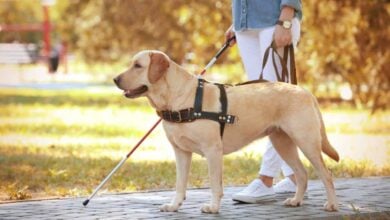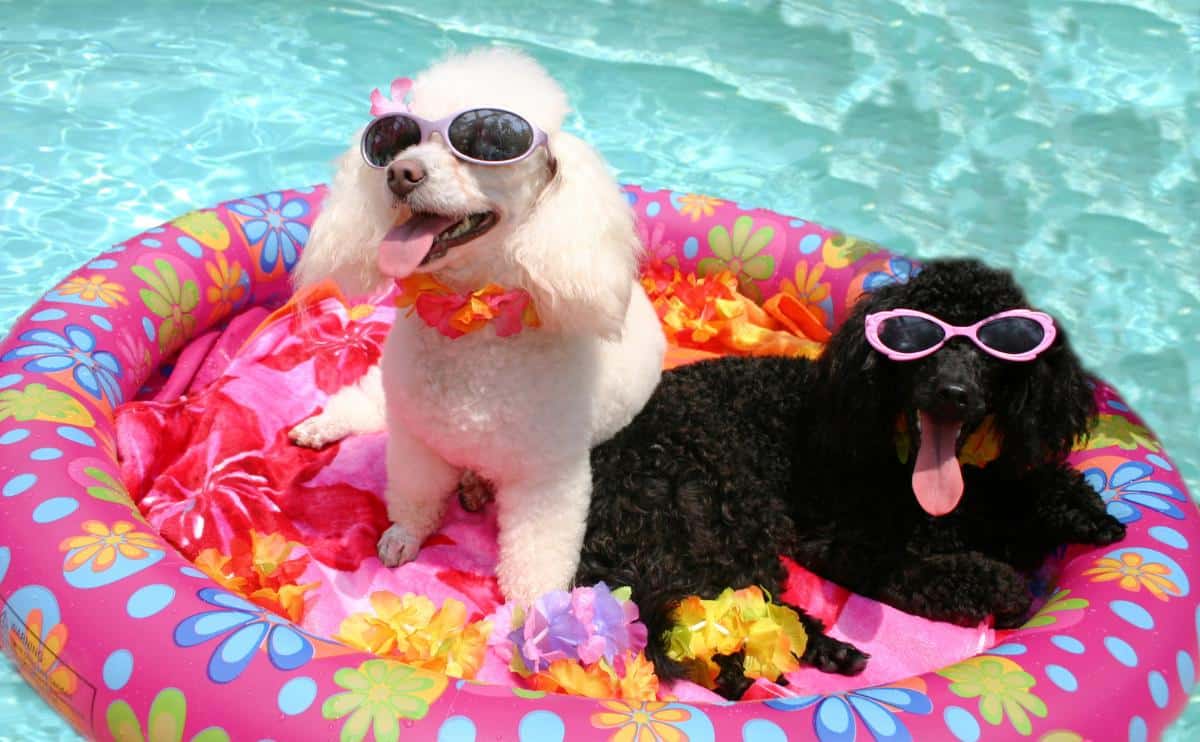When you purchase through links on our site, we may earn a commission. Here’s how it works.
At 2 a.m., when the back gate creaked open, Luna, a 90-pound Bullmastiff, was already at the door. Calm but alert. By the time Sarah reached the nursery, Luna had taken her place between the crib and the noise outside. No panic. Just silent, instinctive protection. That moment is exactly why so many parents start searching for the best guard dogs for families, breeds that don’t just deter threats but also bond deeply with the people they protect.
Table of Contents
It’s not just about strength or size; it’s about finding a breed that can defend your home and love your children like one of their own. The right dog can be your early warning system, your loyal companion, and your child’s best friend, all wrapped into one. But not every protective breed is built for family life.
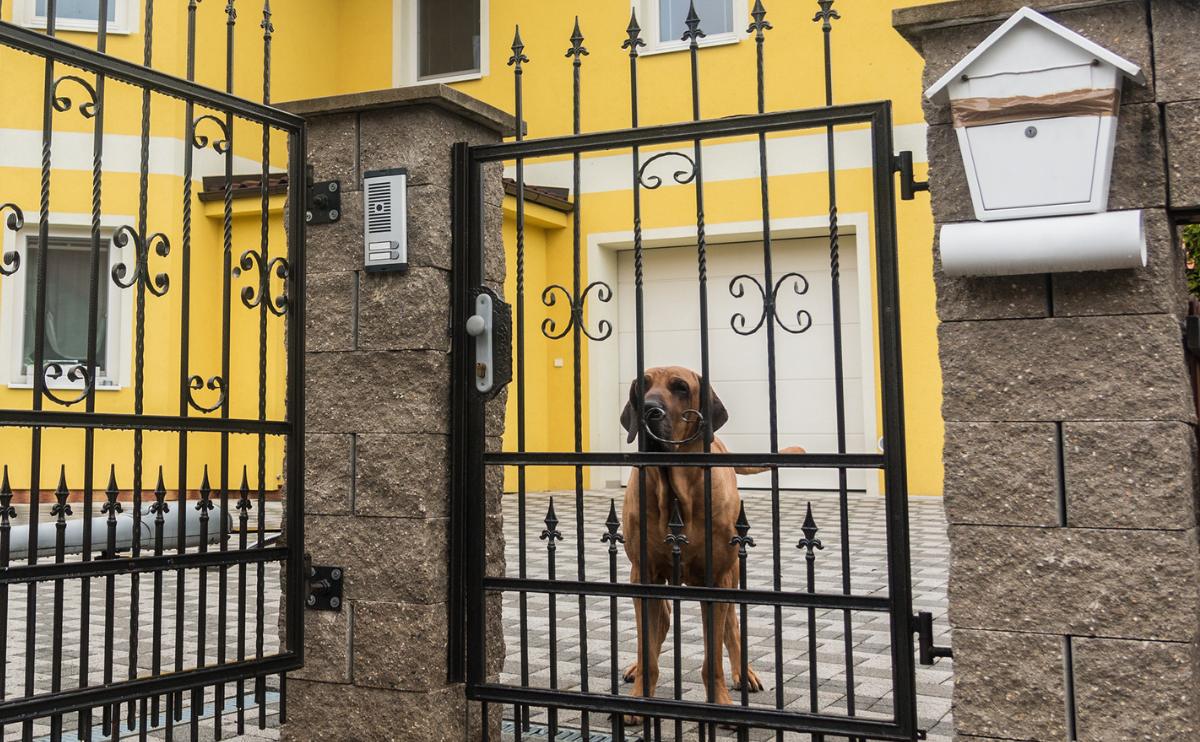
That’s why we’ve curated this guide: to help you discover the most loyal, loving, and trustworthy guard dogs for families, backed by breed traits, real-life experiences, and expert guidance.
Choosing the Right Guard Dog for Your Family
Bringing a guard dog into your home isn’t just about choosing the most intimidating breed. It’s about finding a companion to protect your home while thriving in a family environment. The best guard dogs for families are loyal, loving, and level-headed. They know when to be gentle and when to stand their ground.
Let’s explore the key factors to help you choose the right dog for your household.
5 Traits That Make the Best Guard Dogs for Families Truly Kid-Safe: Key Considerations
When choosing a protective breed for a family setting, look for a balance of instinct, intelligence, and social temperament. The ideal guard dog should possess the following:
- Protective instincts. Naturally alert and territorial without being aggressive.
- Gentleness with children. Calm and tolerant, even around loud or unpredictable little ones.
- Loyalty. Strong bond with family members and a willingness to defend them.
- Trainability. Ability to follow commands consistently, especially under stress.
- Adaptability. Comfortable in various home settings, from apartments to large backyards.
These traits make for a dog that doesn’t just guard. They belong. A good family guard dog offers both emotional comfort and real-world protection.
Temperament vs. Protection Instinct
Some breeds are labeled “protective,” but without the right temperament, they can become overly reactive or challenging to manage in a family environment.
A well-tempered guard dog should remain calm in non-threatening situations. They should be able to distinguish between a real threat and a friendly visitor. Through proper training and exposure, they can learn to respond appropriately.
For example, a Boxer may not appear as intimidating as a Doberman, but they have a naturally watchful personality and are extremely affectionate with children. The best guard dogs for families are not always the most aggressive. They are the ones who know when to step in and when to step back.
Considerations for Homes with Children
Choosing the right dog for your family also means understanding your household’s specific needs.
- If you have young children, look for a breed known for patience and a gentle nature. Avoid dogs that are overly territorial or high-strung.
- If you live in an apartment or a small home, consider medium-sized breeds with lower energy levels, like a Bullmastiff or a Standard Poodle.
- A busy lifestyle also matters. Some protective breeds need daily training, extended walks, and mental stimulation to thrive. The dog may become stressed or reactive if you cannot meet those needs.
Also, consider allergy concerns, shedding, and how much physical space the dog will need. A well-matched dog becomes part of the family, not a source of tension.
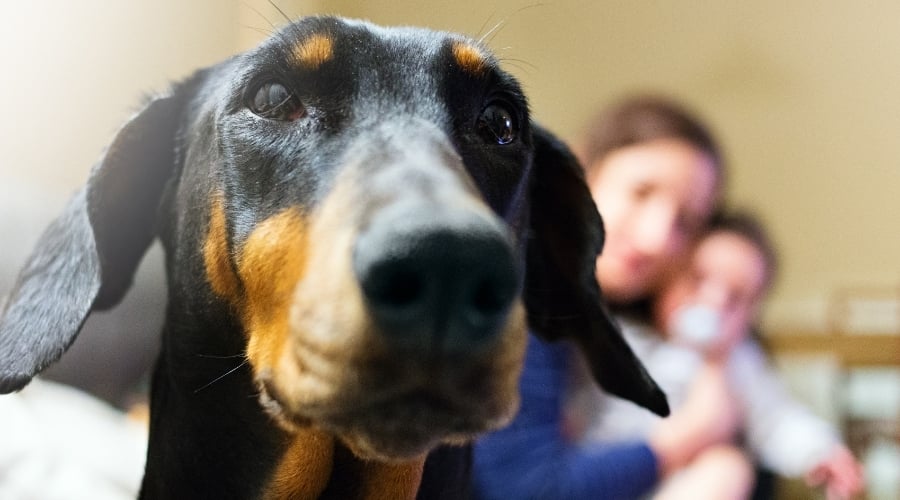
They Are a Family Dog First
At Canine Journal, we believe every guard dog should be a family member first. A dog’s role in your home should be as a companion, not as your only line of defense. While many protective breeds serve as excellent deterrents, their presence should supplement, not replace, a strong home security plan.
We strongly recommend pairing your dog’s natural guarding instincts with a reliable home security system. This protects your dog, your family, and your property, especially when you’re not home.
Top 10 Best Guard Dogs for Families
Now that you know what to look for in a family-friendly protector, it’s time to explore the breeds that stand out as the best family guard dogs. Each of these dogs offers a unique combination of loyalty, protection, and compatibility with children. These are the best guard dogs for families who want safety without sacrificing warmth and companionship.
Continue reading to meet the breeds that protect your home and your heart.
1. German Shepherd
In our opinion, German Shepherds top the list of best guard dogs for families due to their natural instincts to listen, learn, and obey.
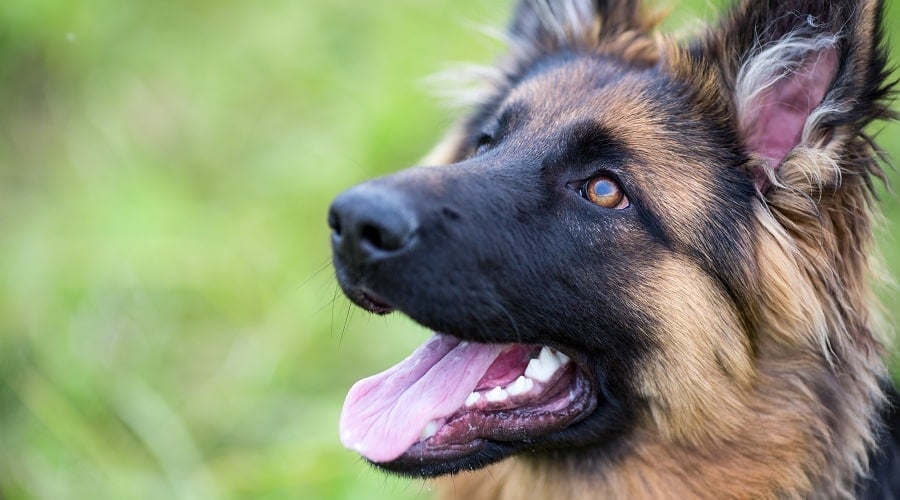
About The Breed
Highly intelligent and fiercely loyal, German Shepherds are one of the most versatile dog breeds. They’re confident, courageous, and deeply bonded to their families. Originally bred for herding and protection, they’re excellent watchdogs and obedient when properly trained.
Originally developed in late 19th-century Germany for herding and protecting sheep, German Shepherds are known for their intelligence, obedience, and courage. Their reputation as police and military dogs reflects their natural guarding instincts and quick learning ability.
Why They’re Great for Families
German Shepherds are devoted to their families and especially gentle with children when properly trained. They are naturally protective, making them an ideal combination of family companions and home defenders. They also typically have fewer health issues than many large-breed dogs.
German Shepherds are both menacing in their appearance and loving in their nature but will respond to commands at any moment’s notice. German Shepherds have thick fur, which makes them respond well to colder temperatures and adds to their toughness.
| Trait | Rating |
|---|---|
| Kid-Friendly | High |
| Protection Instinct | Very High |
| Trainability | Very High |
| Energy Level | High |
| Size | 50 – 90 pounds |
Potential Challenges
They need consistent training and daily mental and physical stimulation. Without this, they may become restless or overly alert.
What to Expect as a German Shepherd Owner
- German Shepherds are most effective when properly trained.
- Their confidence is natural, and they will instinctively stand beside or in front of their owners, even with passive leadership.
- Give your German Shepherd a designated bed or sleeping space.
- Avoid letting your dog sleep in your bed, as they may see it as their own territory, making it difficult to reestablish boundaries later.
- They are eager learners and will actively seek opportunities to impress their owners with what they’ve learned.
- With patience and affection, raising a German Shepherd is relatively mild compared to other breeds.
2. Rottweiler
The Rottweiler, if not properly trained, is too aggressive of a breed to have around small children. However, if properly trained, this is certainly one of the best options for the best family protection dogs. They are described as one of the smartest dog breeds in the world and can be trained to be fantastic guard dogs.
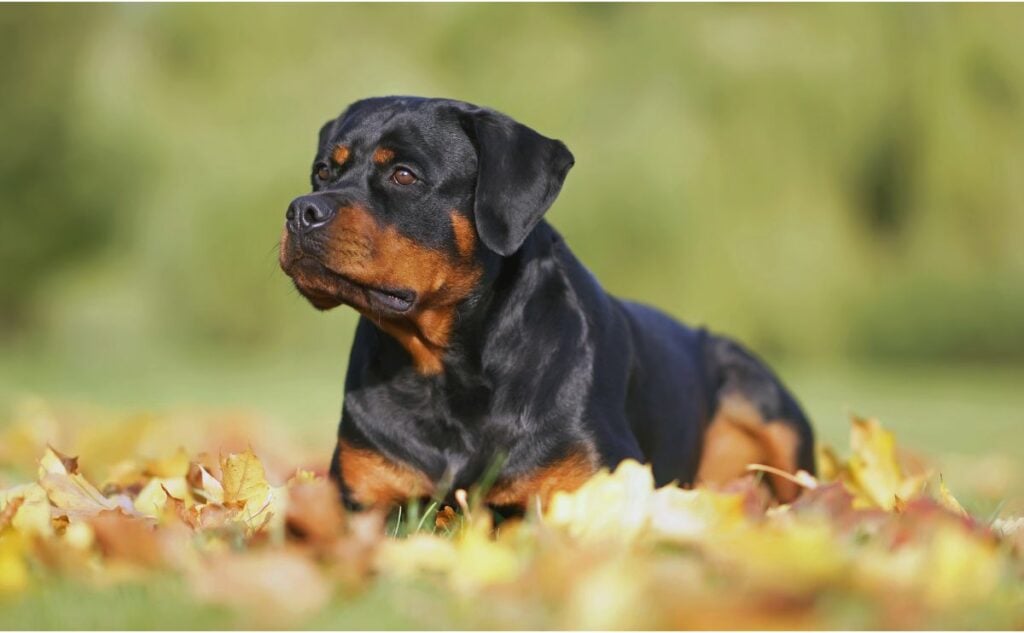
About The Breed
Descended from ancient Roman cattle dogs, Rottweilers were originally used to herd livestock and guard property. Their strength and endurance made them ideal working dogs across Europe. In more recent years, they have been used for personal protection as well as working in law enforcement and service.
This is one breed we encourage to have professionally trained. The Rottweiler is great with families if brought up properly, and even small children are safe under the right conditions. Their intelligence can make them very obedient, and despite their aggressive snarl, these dogs are very loving and ready-to-please animals.
Why They’re Great for Families
When properly trained, Rottweilers are calm, confident, and fiercely loyal to their families. Their natural guarding instincts make them formidable protectors, while their affectionate nature shines with children they’ve bonded with.
| Trait | Rating |
|---|---|
| Kid-Friendly | High |
| Protection Instinct | Very High |
| Trainability | Moderate |
| Energy Level | Medium |
| Size | 80 – 135 pounds |
Potential Challenges
They need clear leadership and early socialization. Without it, they may become overly dominant or wary of strangers.
What to Expect as a Rottweiler Owner
- Intensive and thorough training is essential for the Rottweiler breed.
- Rotties are highly intelligent and naturally inclined to take on leadership roles.
- With firm, consistent guidance, they will submit to their owner and follow commands reliably.
- They have a strong health history and are prone to relatively few diseases.
- The most common health concern is cancer, which is also common in many dog breeds.
- Their feeding should be carefully monitored to prevent overeating or weight issues.
- Excessive exercise can sometimes trigger aggressive behavior, so activity should be balanced.
Real Family Experience: Why I’ll Always Trust a Rottweiler
When we adopted Jade, our Rottweiler puppy, we were looking for more than just a pet. We needed a steady, loyal companion for a disabled family member. From the beginning, Jade showed intuition and emotional awareness that went beyond what we expected. She’s sweet, fiercely loyal, and always alert to the needs of the people around her.
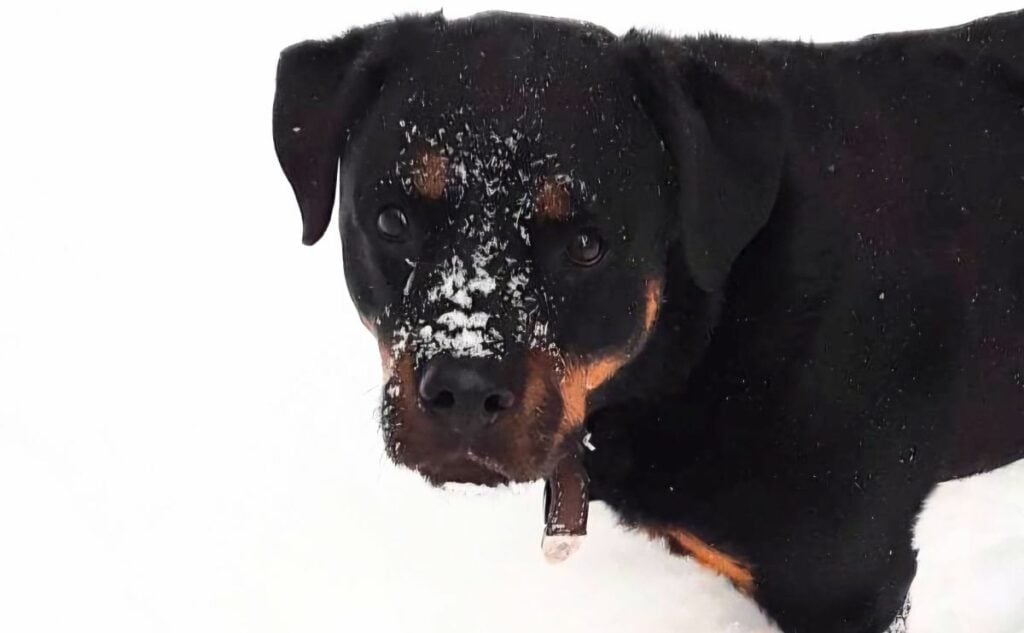
Jade doesn’t just provide companionship. She brings calm to stressful situations and offers silent support in moments of anxiety or unpredictability. Her presence has made a measurable difference in our family’s daily life.
She’s been with us for over a decade now. The journey hasn’t been without challenges; she nearly died from parvovirus as a pup, and we’ve faced a few costly health issues along the way. Her impact has been priceless. One piece of advice: if you adopt a Rottie, get pet insurance early. It helped us when we needed it most.
Jade is more than a guard dog. She’s family. And if given the chance, I’d adopt another Rottweiler in a heartbeat.
3. Bullmastiff
The Bullmastiff has excellent instincts and thrives in family settings, as they learn quickly who their “pack” is and will do everything they can to protect it. They are very aware of everything going on around them, and their intimidating look makes them a wonderful choice for fending off intruders without putting your children at risk.
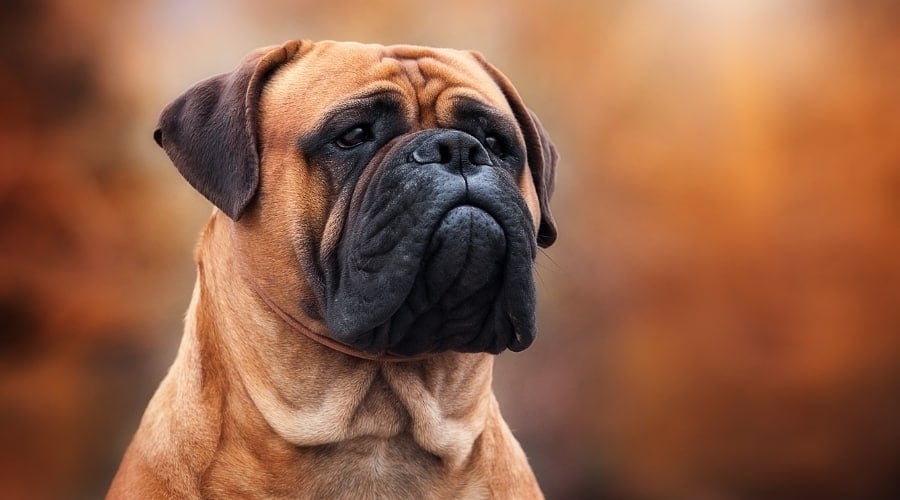
About The Breed
Originally bred in England as the “Gamekeeper’s Night Dog,” Bullmastiffs were designed to catch poachers without mauling them. A mix of Mastiff and Bulldog, they’re large, watchful, and quietly intimidating.
The Bullmastiff was a fantastic tracker, especially at night. They worked quietly and made short work of most escapees and criminals. They eventually moved from roaming outdoors to being primarily domesticated and thriving due to their loyal nature and fondness for their owners.
Why They’re Great for Families
Despite their size, Bullmastiffs are calm and affectionate. They form strong bonds with children and are excellent deterrents simply due to their presence.
Whereas some guard dogs will growl and bark if threatened, the Bullmastiff will show great natural instinct and attacking qualities. They can easily take a full-grown man to the ground. With that being said, once familiar with their home and family, this breed is gentle and loving.
| Trait | Rating |
|---|---|
| Kid-Friendly | High |
| Protection Instinct | High |
| Trainability | Moderate |
| Energy Level | Medium |
| Size | 100 – 140 pounds |
Potential Challenges
Due to their strength, early socialization and leash training are essential. They also do best in homes with adequate space.
What to Expect as a Bullmastiff Owner
- Bullmastiffs need early training and clear structure from the start.
- They should be raised to see their owner as the leader, not the other way around.
- Passive or inconsistent owners may lose control, leading the dog to dominate the household.
- If not properly socialized, Bullmastiffs may not get along with other animals and may view them as threats.
- This can result in growling, barking, and territorial behavior.
- They are not prone to many health issues overall, but joint and hip problems are common in the breed.
- Some Bullmastiffs may also develop heart-related conditions as they age.
- Regular exercise is essential to maintain their health and behavior.
- This breed does best with a strong, confident, and consistent owner.
4. Doberman Pinscher
Doberman Pinschers are extremely loyal and very well-tuned to their owner’s commands if properly trained.
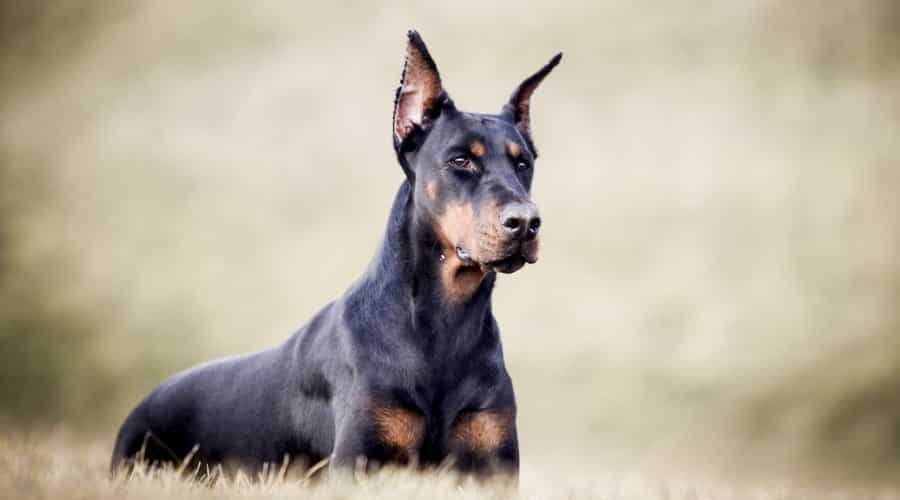
About The Breed
Created in the 1890s by a German tax collector named Karl Friedrich Louis Dobermann, the Doberman was intended as a loyal protector and working dog. Their reputation for intelligence and discipline made them ideal for security and military work.
They were bred to be guard dogs and have maintained those instincts today. The Pinscher was bred from a wide range of breeds but is believed to most closely resemble Greyhounds and Terriers. This mix gives them great athleticism and a loyal attitude.
Health Issues To Know About
Dobermans are prone to several health issues, including heart disease (DCM), Wobbler syndrome, and a bleeding disorder called von Willebrand’s. They can also face thyroid problems, hip dysplasia, liver disease, and bloat. Regular vet care helps catch these early.
Why They’re Great for Families
Doberman Pinschers are a shorthaired breed that requires little more than exercise and food to thrive in a home. They are highly loyal and intuitive. With proper socialization, they are gentle and affectionate with children while remaining highly alert to threats.
Pinschers are a good size, very agile, and athletic. The breed is very alert and cautious of people it is not familiar with but will respect its owner’s command, which makes it great for protecting families.
The Doberman’s growl and bark are equally intimidating, and intruders will certainly think twice before entering your home. They should be raised in a household with children and not brought into a house with small children after they are puppies.
| Trait | Rating |
|---|---|
| Kid-Friendly | High |
| Protection Instinct | Very High |
| Trainability | High |
| Energy Level | High |
| Size | 60 – 100 pounds |
Potential Challenges
They need clear leadership and thrive in structured environments. Without mental stimulation, they may become anxious or overly vigilant.
What to Expect as a Doberman Pinscher Owner
- Dobermans are loyal and protective but require firm leadership and clear boundaries.
- They thrive in structured homes with daily routines, consistent rules, and mental stimulation.
- Early socialization is critical to ensure they are calm and confident around children and visitors.
- They are intelligent and can become bored or destructive without regular training and engagement.
- Dobermans need plenty of exercise and space to release their energy.
- Health concerns may include cardiomyopathy, hip dysplasia, and von Willebrand’s disease.
- This breed is best suited to experienced dog owners who can provide structure and attention.
5. Great Dane
Also called the German Mastiff, the Great Dane is one of the tallest dog breeds in the world. Despite their imposing size, they are gentle, affectionate, and often described as “couch potatoes.” Their calm nature makes them surprisingly well-suited for life with children and other pets, provided early training is prioritized.
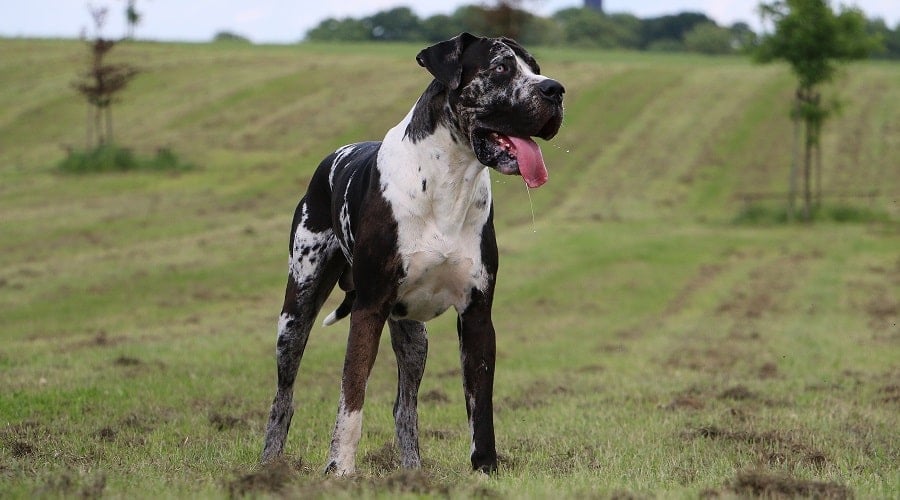
About The Breed
Great Danes have ancient roots, with depictions appearing in both Egyptian and Roman art. Most believe the modern breed developed in Germany and England as boar hunters and estate guardians. During both World Wars, they were also used to track enemy movement, showcasing their scenting ability and intelligence.
Their strength is well balanced, as they are not clumsy and generally have a good idea of their size and place around a home. The Great Dane is much more of a “watchdog” than a “guard dog.” The Dane, despite its size, is actually a very timid breed and shies away from confrontations.
Common Great Dane Health Concerns
Like many giant breeds, Great Danes are prone to hip dysplasia, bloat (gastric torsion), and cardiomyopathy. Their lifespan is typically shorter, averaging 7 to 10 years.
Why They’re Great for Families
Great Danes are watchful but non-aggressive, which means they make excellent deterrents without posing a risk to young children. Their even temperament and intuitive understanding of personal space make them easygoing household companions.
While not true “guard” dogs, they will alert their family to unusual activity and provide quiet reassurance through their presence. From the onset, Danes need to be obedience trained with positive reinforcement. Danes require constant attention until they are housebroken. Once you get the rules set, you are in for a lovable, steadfast companion.
| Trait | Rating |
|---|---|
| Kid-Friendly | High |
| Protection Instinct | Moderate |
| Trainability | Moderate |
| Energy Level | Low-Medium |
| Size | 110 – 175 pounds |
Potential Challenges
Their large size requires ample living space and may not suit small homes or apartments. Great Danes can develop separation anxiety if left alone for too long. Due to their timid nature, they may be overly cautious or shy around strangers.
What to Expect as a Great Dane Owner
- Provide daily low-impact walks rather than strenuous exercise.
- Begin obedience training early using positive reinforcement.
- House-train with consistency and patience, as they need boundaries.
- Offer orthopedic bedding to support joint health.
- Prepare for a short lifespan and potentially high veterinary costs.
6. Boxer
The Boxer descends from the German Bullenbeisser, a hunting and working breed known for strength and agility. Modern Boxers are energetic, fun-loving, and deeply connected to their families.

About The Breed
The Boxer is believed to have originated in Germany in the 16th century. It gets its name from the playful way the breed tends to stand on its hind legs and jab at you with its front paws. The lineage of the Boxer is littered with strands of numerous European breeds, and no one is exactly sure where its true bloodlines lie.
Boxers are known for their bouncy energy, expressive faces, and strong bonds with humans. Athletic and loyal, they’re naturally alert and have a protective streak that kicks in when their family is threatened. Their joyful personality makes them one of the most entertaining breeds to live with.
Boxers are a high-energy breed of dog that does a surprisingly great job at reading people’s intentions. This breed looks more menacing than they are, which is good if you want your guard dog to look intimidating without really having a violent streak.
This breed is very astute and alert, with an energetic enthusiasm for everything they do. Boxers desire affection both from adults and from children and will oftentimes go out of their way to command love and attention. But when it comes to protection, Boxers are very aware of what’s happening and will use their athleticism to protect their family, making this breed a natural guard dog and a top pick for families looking for a reliable watchdog.
Common Boxer Health Concerns
Boxers are prone to heart conditions (Boxer cardiomyopathy), cancer, hip dysplasia, bloat, and various gastrointestinal issues. Regular vet screenings are essential.
Why They’re Great for Families
Boxers are natural clowns with a protective streak. Their playful, affectionate personality makes them excellent around children, while their alertness helps them serve as effective watchdogs.
Boxers are excellent with children. They are protective without being overly aggressive and love participating in family activities. Their intelligence allows them to read human emotion and intention, which is especially valuable in homes with kids. While energetic, their enthusiasm comes from love—not recklessness.
| Trait | Rating |
|---|---|
| Kid-Friendly | Very High |
| Protection Instinct | Moderate |
| Trainability | High |
| Energy Level | Medium-High |
| Size | 48 – 85 pounds |
Potential Challenges
Very high energy as puppies, which can overwhelm small children without supervision. Boxers can be stubborn if not trained early and consistently. They are sensitive to hot weather due to their short muzzle.
What to Expect as a Boxer Owner
- Boxers need daily exercise and mental stimulation.
- Avoid rough terrain or overexertion due to bone sensitivity.
- Train early using positive reinforcement; they are eager to please.
- Keep up with vet visits to screen for breed-specific health issues.
- Feed a high-quality diet and monitor for bloating symptoms.
7. Fila Brasileiros
Also known as the Brazilian Mastiff, the Fila is incredibly loyal and protective, but not for inexperienced owners. They bond deeply with their family unit and are naturally distrustful of strangers. They are among the most territorial guard dogs with strong instincts and a massive presence.
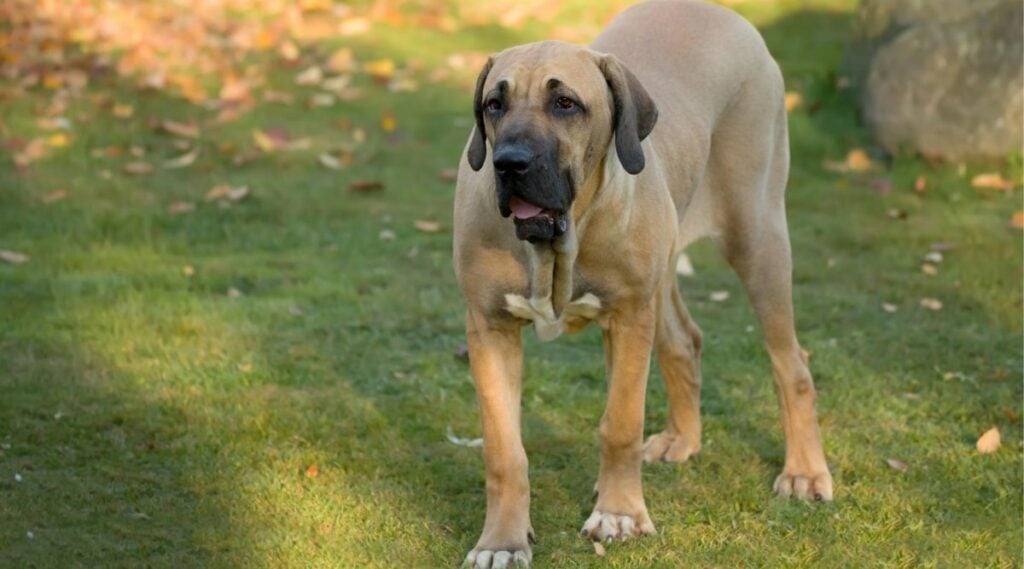
About The Breed
Bred initially in Brazil to guard livestock and track fugitives, the Fila is a mix of Bloodhound, Mastiff, and Bulldog lineage. In the U.S., they were historically used as tracker dogs in law enforcement. Their keen tracking ability and fearless temperament make them well-suited for protection work.
It should be noted that only experienced dog owners should undertake raising and having one around the house. While extremely loyal, the Fila are extremely protective and have been known to attack intruders if they feel alarmed.
A well-trained Fila will be very affectionate and great with kids. In homes where many people come and go, we would avoid the Fila Brasileiros, but because they are so comfortable and loyal to what they perceive to be their family, these make suitable guard dogs.
Why They’re Great for Families
For the right household, especially rural or private homes, the Fila is a devoted protector. They are deeply affectionate with their inner circle, including children, and extremely vigilant about guarding the home. Their protective nature isn’t trained; it’s instinctive.
| Trait | Rating |
|---|---|
| Kid-Friendly | Moderate |
| Protection Instinct | Very High |
| Trainability | Moderate |
| Energy Level | Medium |
| Size | 88 – 180 pounds |
Potential Challenges
Not well-suited for households with frequent visitors or young children unless socialized heavily. Their guarding instinct is so strong that they may not respond well to unfamiliar people, dogs, or situations. Limited availability in some regions and may be restricted under breed-specific legislation.
What to Expect as a Fila Brasileiro Owner
- Only consider this breed if you are an experienced, confident dog owner.
- They are not suitable for homes with frequent guests or busy foot traffic.
- Begin firm training and socialization immediately from puppyhood.
- Provide a large, securely fenced yard.
- Monitor diet to reduce joint and digestive strain.
8. Bernese Mountain Dog
Bernese Mountain Dogs are big, beautiful, and remarkably gentle. They’re strong but slow to aggression, preferring to observe and alert rather than act. Their balanced demeanor makes them ideal for families looking for a protective yet peaceful presence in the home.
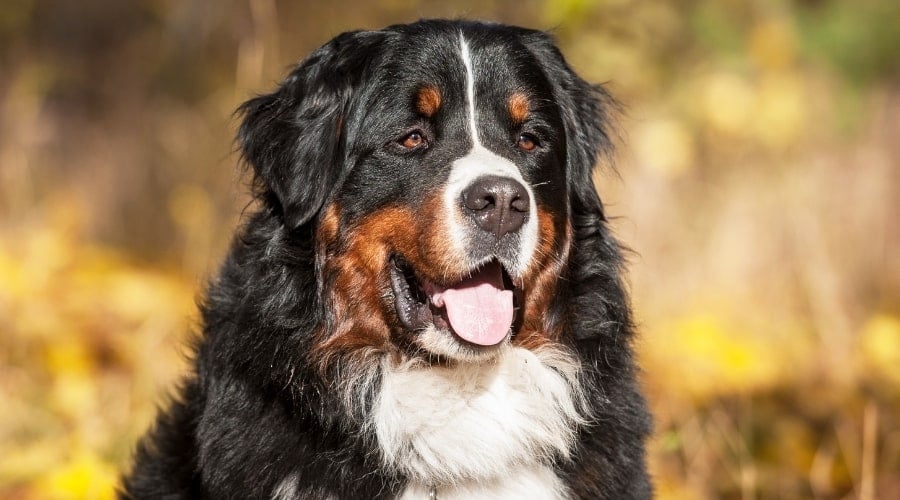
About The Breed
The breed originates from the Swiss Alps, where it was used to pull carts, guard livestock, and accompany farmers through mountainous terrain. Their working background makes them loyal and dependable, traits that easily transfer to family life.
They have, in recent years, become less associated with guarding, but they are very smart and very wary of people they are unfamiliar with. This aspect makes them wonderful to have around the home. They will surely alert owners if something suspicious is going on around the home.
They are not overly aggressive, and expecting them to do much more than bark and growl might be expecting too much. Because of their generous size and fondness for children, Bernese Mountain Dogs are natural family guard dogs.
Common Health Concerns
Unfortunately, the Bernese has one of the shortest average lifespans of any large breed (6–8 years). They are prone to health issues like cancer, hip and elbow dysplasia, and bloat.
Why They’re Great for Families
Bernese Mountain Dogs are incredibly affectionate, especially with children, and tend to be patient even with high-energy toddlers. Bernese Mountain Dogs are protective without being reactive, which makes them great watchdogs in family environments.
Their calm, composed nature makes them ideal companions in busy households, offering a steady, comforting presence. While they are not aggressive, their protective instincts are always quietly at work.
Without overreacting, they’ll position themselves between their loved ones and a perceived threat. This balance of loyalty, sensitivity, and self-control makes them excellent watchdogs who protect through presence and intuition rather than force.
| Trait | Rating |
|---|---|
| Kid-Friendly | Very High |
| Protection Instinct | Moderate |
| Trainability | Moderate |
| Energy Level | Medium |
| Size | 80 – 115 pounds |
Potential Challenges
Bernese Mountain Dogs have one of the shortest lifespans among large breeds, often living only 6 to 8 years, and are prone to serious health issues such as cancer and joint disorders. Their thick coats require frequent grooming, making them poorly suited for hot climates. They can develop separation anxiety if left alone too often and may be slow to warm up to strangers, needing early socialization to build confidence.
What to Expect as a Bernese Mountain Dog Owner
- Limit exercise during warm weather to prevent overheating.
- Offer joint supplements early in life to support musculoskeletal health.
- Keep mentally engaged to avoid boredom or anxiety.
- Grooming is essential due to their long, thick double coat; daily brushing reduces matting and shedding.
- They are best suited for cooler climates, as they are prone to overheating.
- Early training helps prevent stubbornness and anxiety with unfamiliar people.
- Provide gentle, regular exercise without excessive jumping or strain.
9. Great Pyrenees
Calm, stoic, and naturally protective, the Great Pyrenees is a livestock guardian turned loyal family watchdog. They’re intelligent, highly independent, and thrive on responsibility. Their alertness and size are often enough to deter unwanted guests.
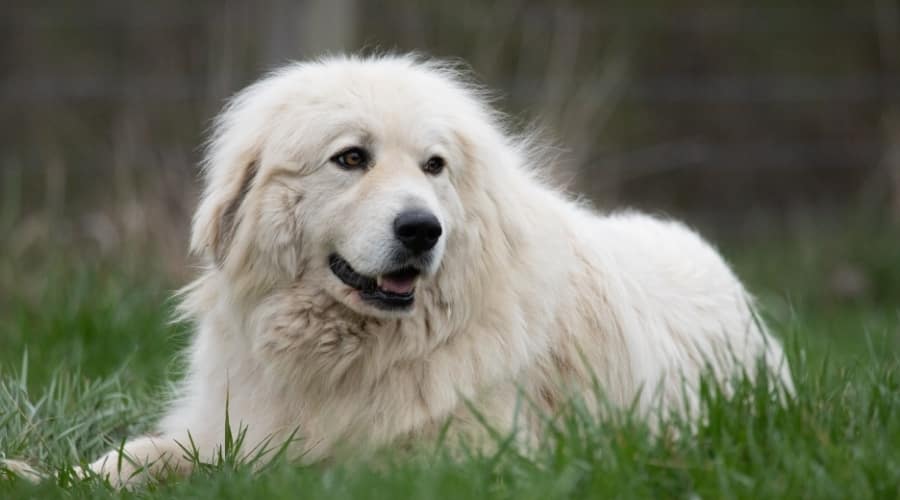
About The Breed
The breed dates back over 2,000 years, with roots in Central Asia and the Pyrenees Mountains between France and Spain. Traditionally used to guard flocks from wolves and bears, they developed a sharp protective instinct and high endurance.
Great Pyrenees are generally thought of as great guardians for livestock. In many cases, they can also be excellent guard dogs for families if given the proper training and attention.
Their thick fur and large stature allow the Pyrenees to work great outdoors or indoors. The Pyrenees is a gentle breed that is both loyal and protective without being overbearing. They are smart dogs that will understand the dynamics of the home while being very wary of guests and intruders.
Why They’re Great for Families
Though naturally stubborn and independent, the Great Pyrenees is a gentle, patient breed that bonds deeply with its family. They are especially affectionate with children and tend to act as quiet guardians, keeping a watchful eye on the household. This makes them one of the best guard dogs for families.
You’ll often find them resting near the kids, calmly observing their surroundings, and springing to attention at the first sign of something unusual.
While they’re not aggressive by nature, their protective instincts run deep. They will bark to alert but rarely escalate unless truly necessary. Their calm presence and innate sense of responsibility make them ideal for families who want a low-key yet highly vigilant companion.
| Trait | Rating |
|---|---|
| Kid-Friendly | High |
| Protection Instinct | High |
| Trainability | Low-Moderate |
| Energy Level | Medium |
| Size | 85 – 120 pounds |
Potential Challenges
The Great Pyrenees are naturally independent, which can lead them to ignore commands if not trained with consistency and patience. They are also known for frequent barking, especially at night or when they sense potential threats near their territory, a trait that may not suit every neighborhood.
In addition, their thick double coat sheds heavily, particularly with the seasons, requiring regular grooming to prevent matting and skin issues.
What to Expect as a Great Pyrenees Dog Owner
- Train early and consistently to overcome stubbornness.
- Expect high levels of nighttime barking if not well-socialized.
- Brush daily to manage their thick coat and avoid matting.
- Use secure fencing—they tend to roam when unsupervised.
- Watch for signs of joint problems and invest in orthopedic support.
- They become very independent as they begin to mature. They will try to become the leader of your household, which can be very frustrating for owners who are passive.
10. Saint Bernard
Saint Bernards are iconic for their size and sweet nature. These dogs are incredibly gentle and patient, making them ideal guard dogs for households with children. While they don’t act aggressively, their presence alone is a strong deterrent.
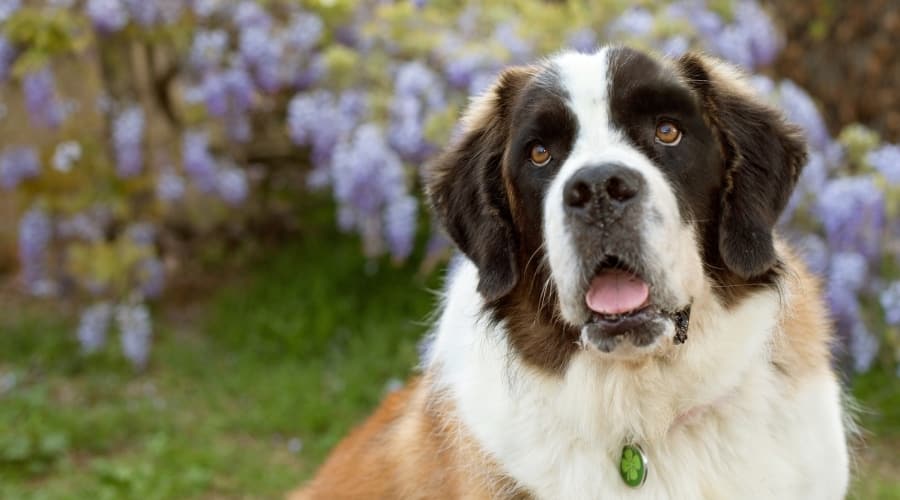
About The Breed
The St. Bernard breed originated in Northern Europe in high altitudes, where they were used to track and navigate through the rough terrain. They are known to have been skilled as valley travelers and would help travelers make mountain passes.
If you have ever seen the movie Cujo, you know how frightening a St. Bernard can be. Contrary to the movie, however, St. Bernards are generally friendly and great with families. The best thing St. Bernards have going for them is their size, as they can often grow to as much as 180 pounds. St. Bernards will not do well as an attack dog.
Their friendly nature will do little once a burglar is in your home, but the size of the dog and the size of the bark will do well to intimidate intruders from breaking in. We will caution about having small children around St. Bernards as they develop. This breed is generally clumsy and will unintentionally knock children down as they grow to understand their size.
Common Health Concerns
Due to their massive size, they’re prone to hip and elbow dysplasia, heart issues, bloat, and a relatively short lifespan of 8 to 10 years.
Why They’re Great for Families
Saint Bernards are famously gentle giants known for their calm disposition and deep affection for children. Often called “nanny dogs,” they have a natural instinct to watch over and care for the youngest members of the family. Their patient personalities allow them to tolerate noise, clumsy hands, and the unpredictable energy of toddlers without becoming agitated.
In a busy household, their steady presence is a source of calm and comfort. Saint Bernards thrive when they’re part of everyday family life, lounging in the living room, napping beside a crib, or gently nudging their way into family activities.
While they may not react aggressively to threats, their sheer size and booming bark are often enough to discourage unwanted visitors. This makes them one of the best guard dogs for families.
| Trait | Rating |
|---|---|
| Kid-Friendly | Very High |
| Protection Instinct | Low-Moderate |
| Trainability | Moderate |
| Energy Level | Low |
| Size | 120 – 180 pounds |
Potential Challenges
Saint Bernards’ massive size makes them prone to joint and mobility issues, and their short lifespan is often accompanied by high food and veterinary costs. As puppies, they can be clumsy and may accidentally knock over small children. Additionally, their thick coat and loose jowls can lead to heavy drooling and tracking in dirt, which may require extra cleanup in the home.
What to Expect as a Saint Bernard Dog Owner
- Begin training early to manage their strength and clumsiness.
- They do not require heavy exercise but need regular short walks.
- Groom two to three times weekly to manage shedding.
- Provide soft bedding and limit jumping to protect their joints.
- Feed high-quality food in smaller meals to reduce bloat risk.
5 Things to Remember Before Getting a Guard Dog
So, you’re thinking about bringing home a loyal protector—the kind of dog that will love your kids, watch the yard, and bark just enough to make delivery drivers nervous. But before you fall head-over-heels for a pair of soulful eyes and a deep bark, here are five must-know truths about choosing a guard dog for your family.
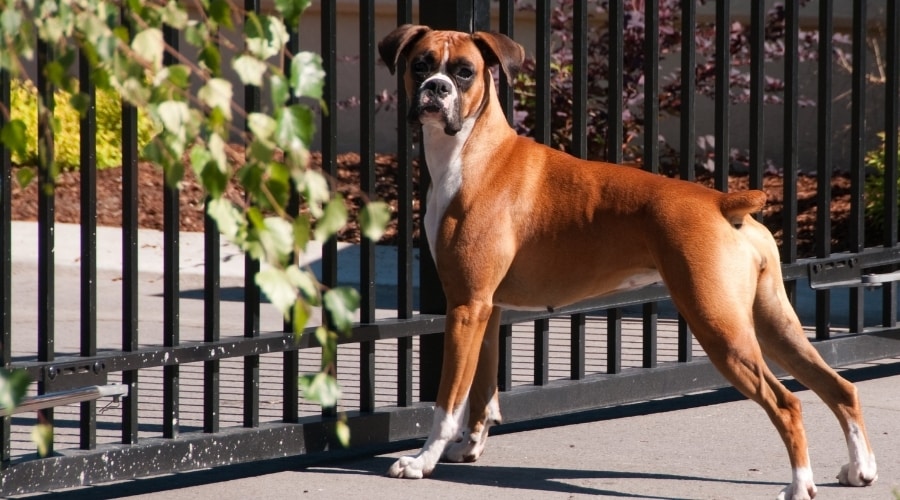
1. Not All Heroes Wear Capes or Bite on Command
Just because a breed is known for protection doesn’t mean every dog in that breed got the memo. Dogs, like people, come with unique personalities. You might adopt a Doberman who prefers belly rubs over barking or a Rottweiler who’d rather nap through a break-in than get off the couch.
Breed reputation is helpful, but individual temperament is what truly counts. Think of it this way: you wouldn’t assume every German is punctual, so don’t assume every German Shepherd is a bodyguard.
2. Genetics: Temperament Runs in the Family
Temperament isn’t just training; it’s also DNA. A dog from a poorly bred line may carry traits like nervousness, reactivity, or unpredictable aggression. That’s why it’s critical to work with ethical breeders or rescue organizations who screen for health and behavior history.
A quality breeder won’t just hand you a cute puppy. They’ll give you the backstory of its parents and, ideally, a history of stability and soundness. Because if Grandpa Dog had a tendency to snap under pressure, there’s a good chance Junior might, too.
3. Environment Shapes Everything
Nature meets nurture in a dog’s first months. A protective breed raised in a chaotic, neglected, or abusive environment can become anxious, reactive, or even dangerous, no matter the bloodline. Dogs thrive on routine, boundaries, and affection. Want a calm, confident protector? Raise them with consistency, love, and clear expectations.
One good example of how the environment can influence a dog’s temperament is a dog that is used in dog fighting. This dog is wrongly trained to be overly aggressive. As this behavior is rewarded, the dog will continue trying to please its master.
The problem with this (aside from the fact that dog fighting is a repulsive activity) is that even dogs that are trained to have aggressive temperaments are temperamental and cannot be trusted. A dog that is trained to be overly aggressive can easily turn on its handler, other pets, or even children in the home.
A peer-reviewed study published in the journal Nature shows that genetic and environmental factors shape dog behavior. They significantly influence canine personality traits such as aggressiveness, trainability, and fear of strangers. Environmental factors, such as early socialization, also play a crucial role
4. Individuality… Your Dog Isn’t a Robot, They Have Preferences, Too
Guard dogs are still dogs. They have moods, quirks, and preferences. You may dream of a fearless protector but end up with a gentle soul who’d rather babysit the toddler than bark at the mail carrier.
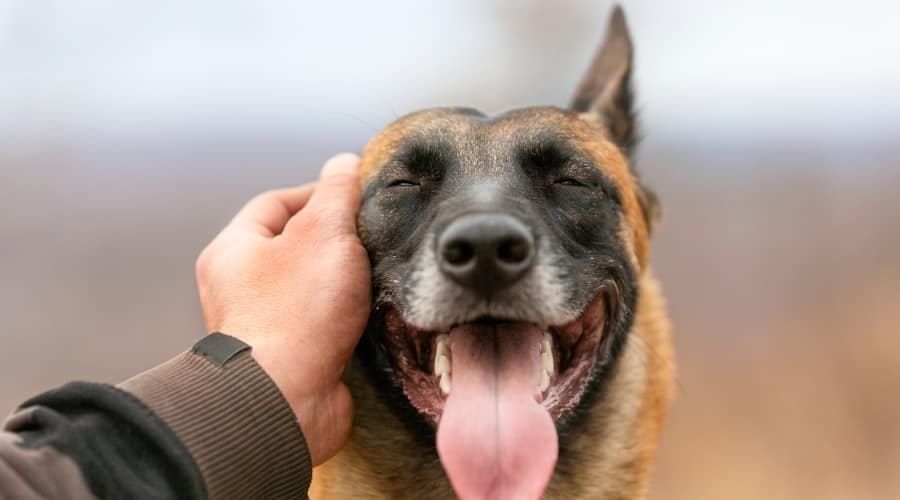
Dogs grow and change with time; just like people, they can surprise you. Be ready to meet your dog where they are, not where the internet told you they’d be. Choosing a guard dog is about finding a compatible partner, not ordering a security system with fur.
People have the tendency to peg one particular breed as being a “good guard dog” because of traits that were initially desired in a breed. It is important to remember that over the years, breeds have changed considerably. Changes along a dog’s lineage, as well as individual likes and dislikes of a dog, are also contributing factors in how a dog ultimately behaves.
5. Health = Functionality (And Fewer Vet Bills)
Even the bravest dog can’t guard your home if they’re sidelined by illness. Chronic health conditions like hip dysplasia, heart issues, or neurological problems can affect a dog’s awareness, agility, and overall responsiveness. Medications, pain, or fatigue can dull their senses.
Before committing, research each breed’s health risks and be honest about what you can manage emotionally and financially. A healthy dog is not just a better guardian—they’re also a happier, longer-living companion.
A great family guard dog isn’t just about bark and muscle but balance. Protection, yes, but also trust, emotional connection, and dependability. When you choose a dog, you’re not just getting a guardian. You’re welcoming a family member who happens to take security very personally.
Guard Dogs and Kids: What Parents Should Know
A well-trained guard dog can be one of the safest and most loyal companions a child can grow up with, but the key is choosing the right breed and setting the right boundaries from day one. Whether you’re bringing home a puppy or adopting an adult dog, here’s what parents should keep in mind.
5 Child Safety Guidelines
These safety guidelines can help everyone be more comfortable. Even with the best guard dogs for families, these rules must be followed.
- Supervise all interactions, especially with younger children. Even the gentlest dog can be startled by sudden movements, loud noises, or accidental pulling.
- Teach kids to respect the dog’s space—no climbing, grabbing, or disturbing while the dog is eating or sleeping.
- Use child gates or crate training to give the dog a “safe zone” they can retreat to when they need a break.
- Avoid rough play that mimics aggression. Wrestling or tug-of-war games can confuse the boundaries of play vs. protection.
- Watch for stress signals like lip licking, yawning, or walking away—these are signs the dog needs space.
Introducing Dogs to Toddlers
Start slow and calm. Allow the dog to observe from a distance and approach at their own pace.
- Use scent-first introductions. Let the dog sniff a blanket or clothing item with the child’s scent before meeting face-to-face.
- Reward calm behavior. Treats and praise for sitting or staying near the child reinforce positive associations.
- Keep early visits short. Short, controlled introductions reduce the chance of overstimulation or nervousness.
Model behavior. Let toddlers see you being gentle with the dog—kids learn how to treat animals by watching you.
A Guard Dog Is Not A Fighting Dog
It’s important to clear up a common misconception: a guard dog is not a fighting dog. While both may be protective in nature, the purpose, training, and temperament of these dogs are fundamentally different—and confusing the two can lead to the wrong choice for your family.
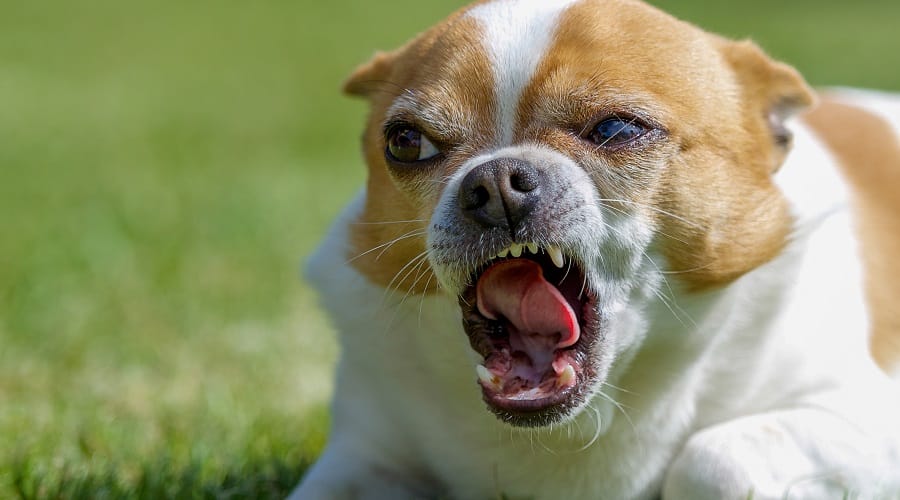
A true family guard dog is a natural deterrent, not an aggressor. Their role is to watch over your home, your children, and your space with calm vigilance. In most cases, their size, posture, and bark are more than enough to stop unwanted visitors in their tracks. Think of them as security personnel, always present and alert but not looking for a fight.
Compare this to Schutzhund-trained dogs (often used in police, military, or riot work). These dogs are trained specifically for controlled aggression, responding to precise commands to bite, defend, or pursue threats. While impressive in their discipline, they are working dogs—trained athletes with specialized roles, not typical household companions.
Most families don’t need that level of aggression. What they need is a dog that’s naturally loyal, observant, and confident enough to stand its ground without being reactive. Breeds like the Bullmastiff, German Shepherd, and Great Pyrenees excel in this role—not because they’re dangerous, but because they’re dependable and inherently watchful.
The best guard dogs for families:
- Use presence and posture as their first defense.
- Respond to threats with awareness, not panic.
- Bark to warn, not to dominate.
- Defend only when truly necessary.
Of course, no matter the breed, training and socialization are essential. A protective dog that isn’t properly guided can become overzealous, anxious, or even dangerous. Professional training, especially for large or high-drive breeds, can help reinforce boundaries, build confidence, and ensure your dog knows when to alert and when to relax.
In short, a guard dog is not meant to fight. They’re meant to protect. And in a family environment, that means offering peace of mind, not fear. All guard dogs need proper training and care. Professional training can be a valuable tool in developing the best guard dogs, regardless of breed.
There’s No One-Size-Fits-All Family Guard Dog
It’s a common misconception that getting a guard dog automatically solves all home security concerns. While certain breeds are naturally protective and alert, relying on a dog as your primary security system is not only unrealistic, it’s unfair to the dog. A guard dog should complement your safety plan, not be your safety plan.
Remember, your dog is a living being, not a surveillance device. Even the most loyal and well-trained dogs can become overwhelmed, distracted, or incapacitated in high-stress situations. That’s why pairing your dog’s protective instincts with a reliable home security system, locked doors, outdoor lighting, and secure fencing is essential.
Before bringing a guard dog into your home, think long-term. Are you ready to treat this dog as a family member first and protector second? Prepare your space thoughtfully: install dog gates, create a safe yard, and ensure your home is dog-proofed, just like you would for a curious toddler. Your goal isn’t just protection; it’s building a safe, loving environment where your dog can thrive while helping keep your family safe

